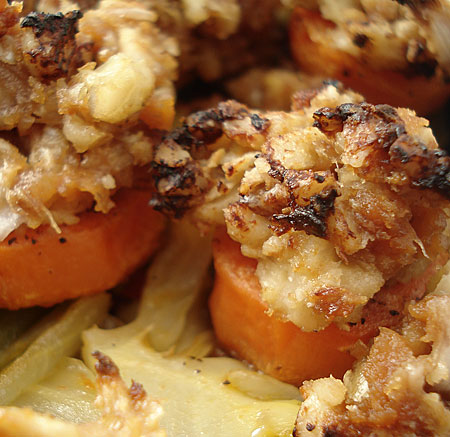
I know that a lot more people read Just Hungry than read Just Bento (and I know a lot read both - thank you!) Most recipes are posted here, but when there is a recipe that works especially well in a bento lunch, I post it on the bento site.
These miso-tahini-walnut topped baked carrots are great for bento, but are really even nicer warm out of the oven. And I think the world needs more tasty vegan protein recipes. So in case you don't read Just Bento, but you are vegetarian/vegan (and this is dairy free and all that, could be made gluten-free quite easily by choosing the right miso...only nut allergy people wouldn't benefit) head on over to Just Bento and check it out. Another one that is very bento-suitable that you might like is _shio kombu_ or kombu no tsukudani, kombu seaweed cooked in soy sauce...I know several people have asked me for a recipe...well, there it is, right there!
Filed under:
japanese nuts vegan
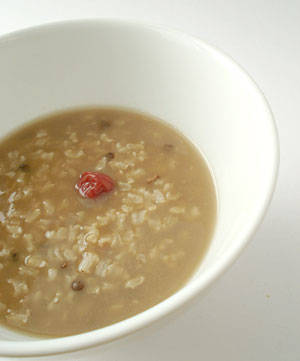 A traditional custom in Japan is to eat nanakusa gayu, or seven greens rice porridge, after the New Year's feasting period, to rest the stomach and bring the body back into balance. At any time of the year, kayu or okayu are eaten when the body is weakened by sickness, fatigue or overeating.
A traditional custom in Japan is to eat nanakusa gayu, or seven greens rice porridge, after the New Year's feasting period, to rest the stomach and bring the body back into balance. At any time of the year, kayu or okayu are eaten when the body is weakened by sickness, fatigue or overeating.
Chagayu or tea rice porridge is a speciality of the ancient city of Nara and the surrounding area. (Nara was briefly the capital of Japan in the 7th century, and is one of the most historical cities in the country). Chagayu is usually made with white rice, but I used brown rice (genmai) instead, plus a small amount of firm green puy lentils from France. The lentils are not traditional, but I like the contrasting texture.
This has been my breakfast for about a week now. It's not in the same category as eggs and bacon or a stack of pancakes, but I find my body needs something like this sometimes to bring it back into balance. It's filling and warming, yet feels very cleansing to the body. A cup of this has less than 100 calories, and is high in fiber.
Filed under:
japanese lighter rice tea vegan
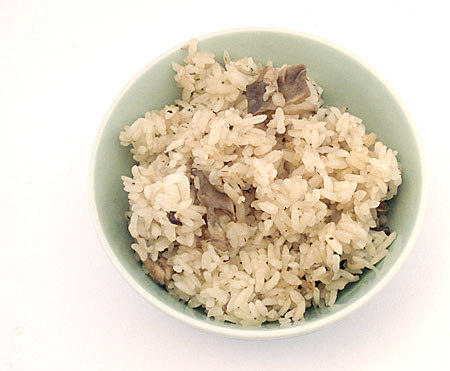
The very first full recipe I posted on Just Hungry almost 4 years ago was Mushroom Rice (kinoko no takikomi gohan), and it still gets a lot of visits and comments, even though there's no photo to whet the reader's appetite or anything.
The original recipe called for traditional dashi stock made from bonito (fish) flakes, and suggested adding chicken and other things.
This version is a lot simpler to assemble and it's all vegan, but it's just as tasty. And it comes with a photo! (My early photos on the site are pretty awful. I like to think I've learned a little since then.) I am using this in an upcoming bento, but it's good for regular dinner too, so it's posted here. It's actually the best when it's freshly made - the aroma of the mushrooms fills the kitchen, quite irresistible if you love mushrooms as I do. It is a very autumn (fall) kind of dish.
I think that this dish reflects my changing tastes and eating habits too, not to mention how I approach writing for Just Hungry, too. 4 years ago, I wasn't that worried about health issues or anything of that nature in regards to food. Now, I am rather proud that I have a tasty dish that is sugar-free, gluten-free (if you use a gluten-free soy sauce), and vegan! I feel a bit trendy.
Filed under:
japanese rice mushrooms fall vegan gluten-free sugar-free
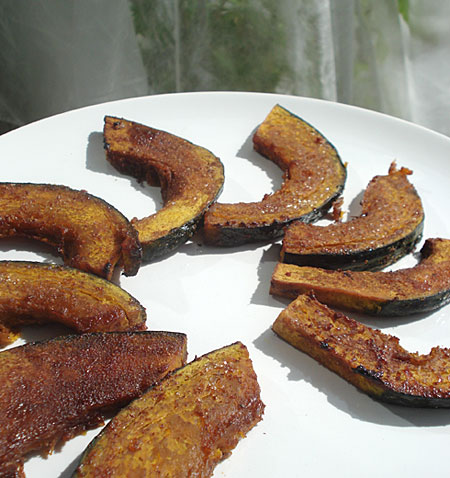
I hesitated to put this recipe up, because it's not the prettiest thing in the world. But it's so tasty, dead easy to make, and of this season - so, here it is. As a bonus it's full of fibre and is relatively low-calorie, low-sugar etc for people who want a bit of something sweet without going on a massive guilt trip.
Most recipes out there for using winter squash seem to involve pureeing them, but I rather like them when they are in chunks or slices. This roasted squash has a sweet, spicy and salty glaze of sorts on them, which brings out the dense sweetness of the fruit. Cut into fairly thin slices like this, it makes interesting finger food. You can vary the sugar and spice to your taste, though too much of either may overwhelm it.
You do need to use kabocha-type squash for this ideally, though butternut should work too. You will need a dense, starchy and sweet squash. Don't use regular pumpkin, which is too watery and lacks sweetness. (Rouge d'etampes pumpkin may work, but I've found their sweetness to vary quite a bit.)
Filed under:
japanese fall vegetarian sweet vegan
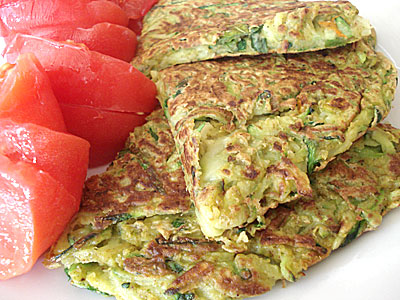
Continuing with my light and quick summer dishes:
This year we got a bit more serious than usual about our garden, and planted three zucchini plants. If you have a garden with zucchinis, you know that sometime around midsummer they start to produce babies like crazy. We've had a rather cold and rainy summer here up until now, but this week our three innocent looking zucchini plants have gone into high gear, and we're picking them as fast as we can before they turn into seedy, tasteless baseball bat sized monsters.
Zucchini pancakes are one way to use up a lot at once. This version uses chickpea flour instead of wheat flour or eggs, with a little bit of spice in it. It's great hot or cold, and is a perfect snack, side dish or complete vegan main dish, since the chickpea flour is such a terrific source of protein and carbs (nutritional info). Serve it with a salsa, curry, or just on its own. Here I just served them with some super-ripe tomato wedges. The shredded zucchini adds moisture and a rather creamy texture, which I love.
Chickpea flour is used in Mediterranean and Indian cooking. I get mine from a local Indian grocery store, where it's sold as gram flour; it's also known as besan, ceci flour, and so on.
Filed under:
lighter vegetables vegetarian summer vegan gluten-free
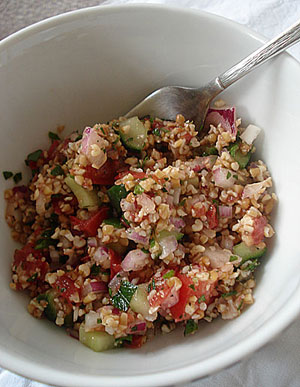
I haven't been posting a lot of recipes here recently. This is mainly because I haven't actually been doing a lot of full-on cooking, as in hauling out a lot of pots and pans and having the oven full blast and so on. It's summer after all, and I've been enjoying fruits and vegetables as close to their natural, fresh, ripe state as possible. So this week I'll be posting a few such recipes - requiring minimal active cooking, full of fresh summer vegetables, and nice to have on a warm summer day or evening.
The first one is my standard recipe for tabbouleh, with a twist - instead of using mint, I use shiso (perilla). Shiso has a slightly minty but wholly unique flavor which I really like in just about anything. I also make it with a lot less olive oil than most recipes call for, which I think adds to the fresh taste. We love to have a bowl of tabbouleh in the fridge for easy self-service lunch and snacks throughout the day - it tastes so healthy and is quite filling. It's also a great side dish for a barbeque.
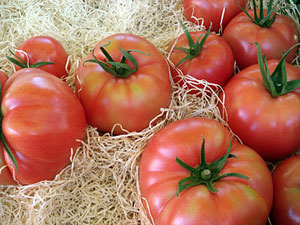
Fresh tomatoes are the key to a great tabbouleh in my opinion. You need ones that are ripe and full of flavor, yet firm. One of my favorite tomatoes at the moment are an heirloom Swiss variety called Berner Rosen - they are a rosy pink when ripe, and full of juice and flavor. (If you're in Switzerland, Berner Rosen are all over the place at the markets right now.) If you can't get hold of a good heirloom variety like this, use cherry tomatoes, which are usually reliably firm yet flavorful.
Filed under:
lighter summer vegan salad
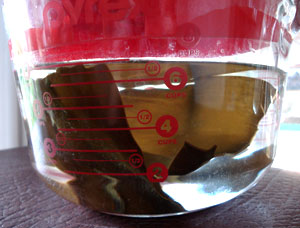
As I've stated many times here over the years, the basis of most Japanese savory foods is a good dashi, or stock. Dashi is not just used for soups, it's used for stewing, in sauces, batters, and many, many other things.
The regular way to make dashi was one of my first entries on Just Hungry. It uses kombu seaweed and dried bonito flakes (katsuobushi). Some people use niboshi, small dried fish, in addition to or instead of bonito flakes.
Katsuobushi and niboshi are both fish-based, so not vegetarian. So how do you make a good vegetarian, even vegan, dashi?
Filed under:
basics japanese soup vegetarian vegan
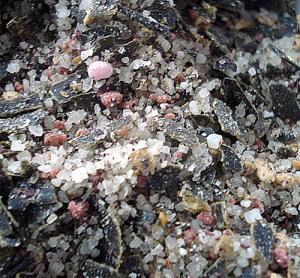
If you browse the aisles of a Japanese grocery, you may run across various instant tsukemono mixes. These come either in liquid or dry form. The dry granules in particular are very handy to have around, and they can make sokuseki zuke in a hurry. However, they usually contain MSG, preservatives and such.
Scouring around the Japanese parts of the interweb, I came across several pages that had recipes for a homemade instant tsukemono mixes, such as this one. They all used MSG or dashi stock granules though, and I wanted to come up with a mixture that was made up 100% of natural ingredients.
After some tinkering around and almost ruining the motor of my food processor, here's the mixture I came up with. To up the umami quotient it has a full 100 grams of finely chopped konbu seaweed in it. It also has some interesting very Japanese ingredients in it such as dried yuzu peel and yukari, dried powdered red shiso leaves.
Filed under:
japanese ingredients vegetarian vegan tsukemono
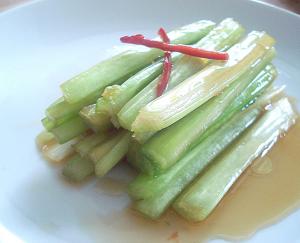
Celery isn't a very Japanese vegetable, but with the addition of the right flavors it can be turned into a refreshingly crunchy pickle that goes well with white rice, which is the base criteria for determining whether a pickle fits a Japanese meal or not. Besides, I always seem to have some celery in my fridge (who doesn't?), and this is a good excuse to use some up.
This is a nice salad-like pickle, that's best eaten with some of the pickling liquid spooned like dressing over the top. There's a nice bite and a color zing from the thin slivers of red chili pepper. (Pirikara means spicy-hot.) There's a little sake and mirin in the dressing, which gives it a twist.
Since celery is more fibrous than cucumber, it needs to marinade for a bit longer. Give it at least 3 hours, or overnight. It doesn't keep too well at room temperature, so reserve this for eating at home. It assembles as quickly as the other quick pickles in this series.
Filed under:
japanese lighter vegetables vegetarian vegan salad tsukemono
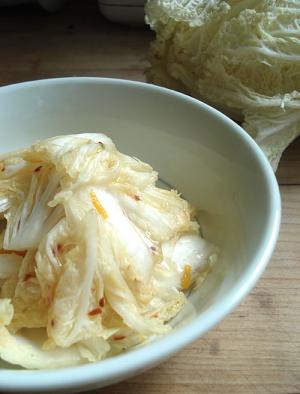
This has to be one of the easiest and tastiest ways of preparing Chinese or napa cabbage (hakusai) that I know of. All you taste is the fresh essence of the cabbage, with the heat of the red pepper and the slight twist of the orange zest.
Did I say easy? Wash and chop up the leaves, mix together the flavoring ingredients, dump all in a plastic bag, shake then massage. That's it. It's ready to eat right away, though the flavors to meld a bit better if you can manage to keep it in the fridge for at least an hour before eating.
I've used ingredients that anyone should have, even if you aren't stocked up on typical Japanese ingredients. Adjust the amount of red pepper flakes up or down to your taste.
Filed under:
japanese lighter vegetables vegetarian quickcook bento vegan under10 tsukemono
Pages